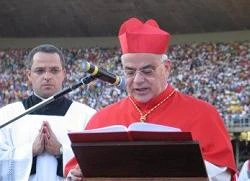
.- Today the prefect of the Congregation for the Causes of Saints, Cardinal Jose Saraiva Martins presented the anticipated Instruction, “Sanctorum Mater” to increase the rigor of the sainthood process.
The new restrictions are expected to diminish the number of candidates proposed to the Vatican for recognition.
In his remarks, the Portuguese cardinal explained that the Instruction is divided into six sections.
“The first draws attention to the need for a true reputation of holiness before beginning a process, and explains the duties and roles of the petitioner, the postulator and the competent bishop,” the cardinal said.
“The second part describes the preliminary phase of the cause which extends as far as the 'Nihil Obstat' of the Congregation for the Causes of Saints.” The ‘Nihil Obstat’ is a status given to the works of the person in question which certifies that nothing in their teachings contradicts the teachings of the Church.
“The third section concerns the instruction of the cause. The fourth part concentrates on the gathering of documentary proof and the fifth on the gathering of proof from witnesses. Finally, the sixth section of the document outlines the procedures for the closing of the inquiry,” he explained.
Cardinal Martins also explained the need for the publication of the document. “In some dioceses, certain provisions of the law have not always been understood and, consequently, not been put into practice with the necessary meticulousness, which has sometimes made it necessary for the congregation to supply clarifications or to ask diocesan curias to correct errors.”
He continued, “dioceses do not always have access to specialized individuals with practical experience of the various procedures involved in a cause of canonization.” For this reason, “it is evident that a practical document, such as this Instruction, was useful, indeed necessary.”
The new norms are also expected to clear up confusion regarding the methodology of the process.
“When the current legislation on causes of saints came into force,” said the cardinal outlining another reason for the publication of the present document, “an unfounded idea became widespread that the traditional methodology ... had been substituted by some kind of historical-critical investigation.”
The reason for this confusion was “the fact that the term 'inquisitio' used in Latin (the only official text) to designate the procedure of the diocesan phase of a cause of canonization was translated in Italian as 'inchiesta' (inquiry)". The new Instruction, then, highlights "the importance of procedure" in causes of beatification and canonization, "and accurately highlights the norms that must be observed."
A final reason for issuance of the document is to emphasize the significance of the “fame of sanctity or martyrdom.”
According to Cardinal Martins, some dioceses or others promoting a potential saint’s cause were not aware that a reputation for holiness “is a prior requirement of absolute importance.”
Lest a person’s reputation for sanctity be built up by their cause for sainthood being introduced, the cardinal insisted that “a procedure must not begin without irrefutable proof that the Servant of God ... is held to be a saint or martyr by a considerable number of faithful, who invoke him or her in their prayers and attribute graces and favors to his or her intercession.”
During the pontificate of Benedict XVI, there have been 20 beatification ceremonies during which 563 Servants of God were beatified, including 48 diocesan priests, 485 male and female religious, and 30 lay people, for a total of 509 men and 54 women.
The canonization ceremonies celebrated thus far during the pontificate of Benedict XVI number four (three in Rome and one in Brazil), during which 14 people were canonized.
According to the Press Office of the Holy See, the current total of saints and blesseds of Pope Benedict’s pontificate is 577.
Source: http://www.catholicnewsagency.com/new.php?n=11812
